Monday, December 19, 2022
Audience Survey
Using The Greenscreen

Sunday, December 18, 2022
Sample Scene 3
 Our location was the forest near my house, we chose it since it was easy to access and has a lot of variety in the path and trees. It was also close to the street we were using to film the next scene, and was well lit in the dark.
Our location was the forest near my house, we chose it since it was easy to access and has a lot of variety in the path and trees. It was also close to the street we were using to film the next scene, and was well lit in the dark.
For costume, we wanted to use everything to include in our final cut. We wanted to reflect the character archetypes of slasher, and use signifiers, such as the letterman jacket and the short skirt to anchor these tropes. The full detail for costume is on the blogpost here .
The main issue we encountered was due to the cold temperatures and hail. Although we had brought jackets for the cast they were not warm enough while shooting, which caused a lot of delays. If reshooting, or for our burial scene, we would plan on wearing warmer layers.
- Sense of stalking wasn't created
- Phone pings timings don’t sync up
- Shots of ground is unnecessary, can cut scene shorter
- We can clearly see her shaking, mask the elements of coldness
- The false scare
- Connotations of drinking, smoking, and sex as "sinful"
- Zoom in on the phone to show the text better
- Bottle isn't seen well
- Unnecessary unscrewing shot, and re-screwing is too long
- Can see the cigarette is broken, cut to hide that
- Zoom in or zoom out when jumping between shots to flow better
- Close up reaction to vodka can be taken out
- Remove camera shake during scare
- Dialogue seems ingenuine ("slash my throat")
- Bad dialogue audio, rerecord
Thursday, December 15, 2022
Costume
 Initially, we wanted to stick to the early 2000s aesthetic since these were the films that inspired us. We want to signify a 'clique', to show the connection of the three girls. We would do this through the use of matching hoops. Each girl has her unique colour: white, pink and purple. Our main inspiration for the colour coded clique is from Heathers (1988), and Mandy's costume is inspired by Jennifer's Body (2009).
Initially, we wanted to stick to the early 2000s aesthetic since these were the films that inspired us. We want to signify a 'clique', to show the connection of the three girls. We would do this through the use of matching hoops. Each girl has her unique colour: white, pink and purple. Our main inspiration for the colour coded clique is from Heathers (1988), and Mandy's costume is inspired by Jennifer's Body (2009). 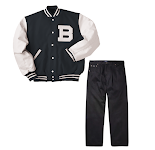
Wednesday, December 14, 2022
Katz and Blumler: Uses and Gratifications Theory
 |
| Maslow's hierarchy of needs |
Possible influences for my film:
Tuesday, December 13, 2022
Four Quadrant
What does Four Quadrant film mean?

A four quadrant film refers to a film that appeals to all four major demographics or “quadrants”, these are; male, female, young (under 25), and old (over 25).
Larger budget films often appeal to a four quadrant audience as they aim to be as commercially successful as possible. Working Title, the subsidiary of the vertically integrated conglomerate Universal uses this as they aim for commercial success. This is contrasted by the indie film company Warp, which has a niche target audience as they focus on representing minorities.
Example of a four quadrant film:
This Working Title film appeals to a four quadrant audience:
The High Note (2020)
The protagonist is played by Dakota Johnson, a young, conventionally attractive female. This appeals to a young female audience through the Uses and Gratifications theory of personal identification, appealing to younger and older women, as well as attracting a male audience through Mulvey’s male gaze theory. The other protagonist is played by Tracee Ellis Ross, an older female, which serves as personal identification for older women, and attracts a male secondary audience. Ice Cube plays in a supporting role allowing for personal identification with an older male audience.
Inspiration for my film:
As we are indie producers making a slasher film, we are appealing to a niche audience. This means that the four quadrant approach is not as needed for our film, but if it was a full length feature we would have an older cast playing police officers, parents, or teachers in order to appeal to a secondary older demographic.
Sunday, December 11, 2022
Script (Process and Evolution)
To simplify our process, we decided to create a separate script for each scene we shot.
Sample Scene 1:
Street Scene and Forest Scene:

Final Full Script by Laura Fagan on Scribd
Saturday, December 10, 2022
VODCAST: Slasher Genre Conventions
Transcript:
In this vodcast I will analyse the following slasher conventions: the killer, the setting, character archetypes, character separation, signals, jump scares, illogical thinking, sounds, shots, and lighting.
Monday, December 5, 2022
Box Office Analysis: Low Budget Horror
In order to estimate a budget for my film, as well as to pitch to potential distributors, I have complied an analysis of high grossing, low budget horrors, as well as analysed their franchises.
Low Budget Horror Analysis by Laura Fagan on Scribd
SLASHER GENRE: Character Archetypes
In this post I will analyse the following slasher character archetypes; the killer, the jock, the fool, the nice guy, the scream queen and the final girl, as well as treatment of minorities and adults.
I will be mainly referring to the films The Cabin In The Woods (2011) , The Final Girls (2015) and The Babysitter (2017) , as they are post-modern films satirising these archetypes.
Sunday, December 4, 2022
Box Office Analysis: 10 Horror Films
Media 10 Horror Films by Laura Fagan on Scribe
In conclusion:
Thursday, December 1, 2022
Hall: Reception Theory
Stuart Hall
What is Reception Theory?
- preferred reading: the way in which the original author intended the text to be recieved based on the meaning they had created- negotiated/contested reading: only certain aspects of the preferred reading are accepted and the rest are not recognised or rejected- oppositional reading: the conscious or subconscious rejection of the authors preferred reading
Possible influences for my film:
Wednesday, November 30, 2022
Barthes: Narrative Enigma
Roland Barthes
What is Narrative Enigma?
Possible influences for my film:
Todorov: Narrative Structure
Tzvetan Todorov
What is Narrative Structure?
Example:
Tuesday, November 29, 2022
Male Gaze and Voyeurism
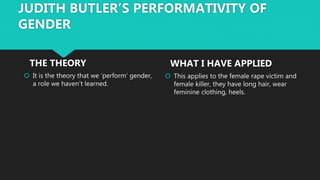
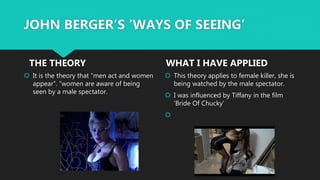

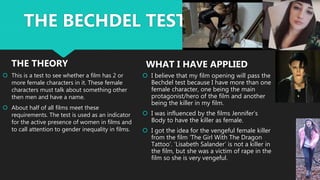

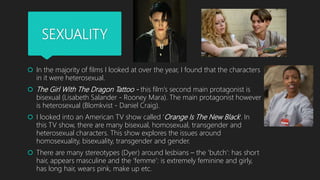
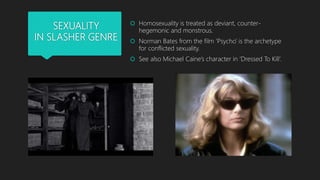



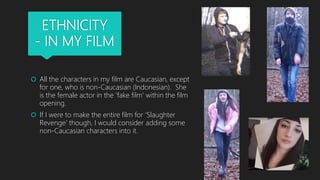


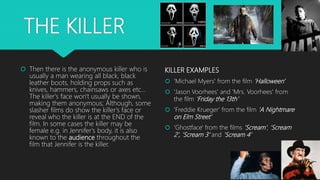
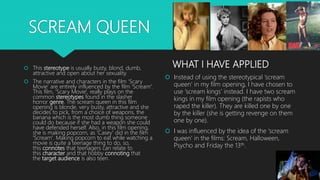

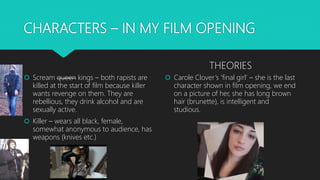
 The Male Gaze:
The Male Gaze:
"the perspective of a notionally typical heterosexual man considered as embodied in the audience or intended audience for films and other visual media, characterised by a tendency to objectify or sexualise women."
- the man behind the camera- the male character- the male spectator
Background:
The first documentation of "the gaze" or "le regard" was introduced by the French philosopher Jean-Paul Sartre in 1943. He described it as "the act of gazing at another human creates a power difference, felt by the gazer viewing the gazed as an object rather than a human being."
The first use in cinema was by John Berger in 1972's "Ways of Seeing", where his theory stated that "men act and women appear", with women being aware of their obligation of performance towards the male viewer.
It most notably appears in Laura Mulvey's 1975 essay "Visual Pleasure and Narrative Cinema". In this essay, she states, "In a world ordered by sexual imbalance, pleasure in looking has been split between active male and passive female." (808), relating the representations of women and men in cinema to the patriarchal structure of society. These representations deny the post-feminist theory of agency, or a woman's control over her actions and body, dehumanising her and being viewed as a body rather than a person.
Psychology of the theory:
Mulvey based her essay on several Freudian psychoanalytical concepts:
Male Castration Anxiety: Upon viewing the woman, her lack of phallus poses the threat of castration to the male, and therefore displeasure. This unconscious anxiety of the male in turn leads to the over sexualisation and passive role of women onscreen, through voyeurism and fetishisation.
Voyeurism: The behaviour of looking as a sexual pleasure . Mulvey states it is about "asserting control and subjecting the guilty person through punishment or forgiveness." By viewing and fragmenting the female body, the anxiety of castration is reduced.
Scopophilia: The receiving of pleasure from looking, relating to the effects of the male gaze on both men and women. When the pleasure is derived from sexual attraction, it falls under the voyeuristic pleasure. However, when women view film from the male perspective, their pleasure is derived from self-identification and narcissism.
Narcissism: Receiving pleasure from the contemplation of one's self, in this case women identifying with their onscreen objectification.
Spectatorship:
When viewing a film, the viewer assumes the role of the active male or the passive female. Mulvey states that the male gaze consists of "three different looks"; the camera, the audience, and the characters. They all share the perspective of the active male viewer, relating to the concept of scopophilia or pleasure from viewing. This is in turn separated into two categories; voyeurism, where the subject is viewed from a distance and the viewer projects onto them, or narcissism, where the subject is recognised within it's viewer.
Due to this system of viewing, Mulvey believed women must identify with male characters and their perspective in order to enjoy films.
Onscreen, the male perspective is physically distinguishable in the camera's sight line and women are objectified to appeal to the male character, or male viewer. This is reinforced by the patriarchal hegemony (Gramsci), as well as other forms of media.
Rejection of the gaze:
Camille Paglia, a feminist academic writer, rejected the theory of the male gaze, by prioritising the post-feminist theory of agency. She says "I've been very vocal about my opposition to the simplistic theory of the male gaze... (it is) the victim model of feminism applied to the works of culture."
The female gaze was idealised later, with the idea consisting of a female assuming the position of the dominant male, and viewing through this perspective, removing the objectification of women.
Queering the gaze, consists of a same sex viewer and object, therefore queering the passive and active or male and female roles. However, this is also criticised by many feminist theorists, specifically regarding the lesbian gaze, referring to the fetishisation occurring from the heterosexual male.
Welcome To My Blog!
Hello! My name is Laura and this is my blog tracking my AS Media Coursework from 2022-2023. I specifically researched film openings and the...

-
Background and development: It develops from passive media theories such as the hypodermic needle model from the 1940s, which places the ...
-
EVALUATION Q1a: How Does Your Product Use Or Challenge Conventions? To summarise this question in a creative way, I decided to replicate Vog...
-
Tzvetan Todorov (b. 1939- d. 2017) Tzvetan Todorov was a Bulgarian-French historian, philosopher and literary critic. What is Narrative St...















